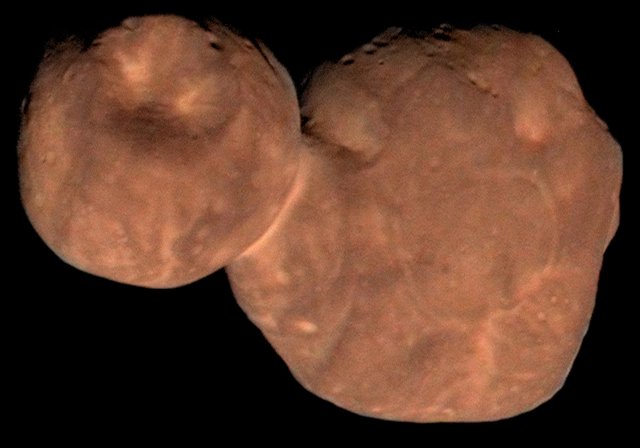Lesson .
.Cold Case: A 'Pi in the Sky' Math Challenge
Overview
The "Pi in the Sky" math challenge gives students a chance to find solutions to real-world problems all while using math and pi just like NASA scientists and engineers. In this problem from the seventh installment of the set, students use the mathematical constant pi and physics to calculate how long the Kuiper Belt object Arrokoth takes to orbit the Sun.
Materials
- Pi in the Sky 7: Cold Case – Download PDF
- Pi in the Sky 7: Cold Case answer key – Download PDF (also available as a text-only doc)
Background

In January 2019, NASA's New Horizons spacecraft sped past Arrokoth, a frigid, primitive object that orbits within the Kuiper Belt, a doughnut-shaped ring of icy bodies beyond the orbit of Neptune. Arrokoth is the most distant Kuiper Belt object to be visited by a spacecraft and only the second object in the region to have been explored up close. To get New Horizons to Arrokoth, mission navigators needed to know the orbital properties of the object, such as its speed, distance from the Sun, and the tilt and shape of its orbit. This information is also important for scientists studying the object. In the Cold Case problem, students can use pi to determine how long it takes the distant object to make one trip around the Sun.
Procedures
In January 2019, NASA's New Horizons spacecraft flew within 3,538 km of the most distant and primitive object explored up-close by a spacecraft. The object was originally known as 2014 MU69, but it was later renamed Arrokoth. It looks like a partially flattened, reddish snowman and is made up of two objects that merged into one. Found 6.6 billion km from Earth, Arrokoth is a small “Cold Classical” Kuiper Belt object, meaning it orbits the Sun in a nearly circular path and has a low orbital inclination. Cold Classical objects make up about one-third of the Kuiper Belt.
One reason scientists are interested in studying Arrokoth and other Kuiper Belt objects is that they are thought to be well preserved, frozen samples of what the outer solar system was like at its birth, more than 4.5 billion years ago. Learn a bit more about Arrokoth by calculating how long it takes the object to make one trip around the Sun.
Assessment
Extensions
Participate
Join the conversation and share your Pi Day Challenge answers with @NASAJPL_Edu on social media using the hashtag #NASAPiDayChallenge
Blogs and Features
Related Lessons for Educators
Related Activities for Students
Multimedia
Facts and Figures
Missions and Instruments
Websites
Lesson Last Updated: Oct. 11, 2024















